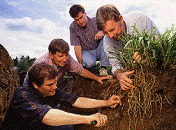United States Department of Agriculture: Agricultural Research Service, Lincoln, Nebraska

United States Department of Agriculture-Agricultural Research Service / University of Nebraska-Lincoln: Faculty Publications
Document Type
Article
Date of this Version
7-2025
Citation
Jia, Y., Jackson, A.K., Green, B.W., Fuller, S.A., Box, H., Sells, L., Ray, C., Harper, P., Smith, B. 2025. Primary investigation of rice-fish co-culture: Investigating the feasibility of raising fish in flooded rice paddies in the Southern USA. PLoS One 20:e0327572. https://doi.org/10.1371/journal.pone.0327572
Abstract
With limited land and water resources available it has become critical to maximize output for agricultural products while maintaining sustainable farming practices. Ricefish co-culture can be used to maximize limited land and water resources for production of rice and fish concurrently and reduce the need of chemical inputs. While rice-fish co-culture has been practiced in Asia for centuries, very few studies have examined the feasibility and economic impact of rice fish co-culture in the U.S.A. Two studies were conducted in Stuttgart, Arkansas, U.S.A. from 2023-2024 to investigate the suitability of raising Koi carp in flooded rice paddies with a sushi rice variety, Eclipse. The objectives of the studies were to determine if co-cultivation of Koi carp and rice in the Southern U.S.A. could enhance rice production and quality while providing additional economic return from Koi carp. Our studies showed that Koi carp with two different initial weights can be grown concurrently in a flooded rice-fish production system and result in enhanced rice yield, milling yield, and protein content, and positive estimated net returns for Koi carp production. This system appears to offer U.S.A. rice farmers a potential diversification strategy for smaller fields where specialty rice varieties are grown, however, a full economic feasibility study still is needed.
Included in
Agriculture Commons, Agronomy and Crop Sciences Commons, Aquaculture and Fisheries Commons


Comments
US Govt publication